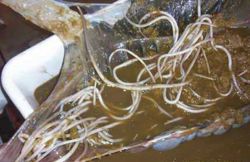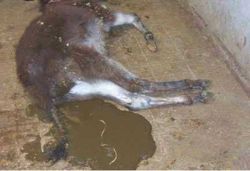Difference between revisions of "Ascarids - Donkey"
m (Changed protection level for "Ascarids - Donkey" ([edit=autoconfirmed] (indefinite) [move=sysop] (indefinite))) |
|||
| Line 3: | Line 3: | ||
==Introduction== | ==Introduction== | ||
[[Image:Parascaris equorum donkey.jpg|right|thumb|250px|<small><center>Adult ''P. equorum'' in a four-year-old donkey that died of colic. Most worms were found blocking the ileocaecal junction and in the caecum, with a few in the small intestine. (Image courtesy of [http://drupal.thedonkeysanctuary.org.uk The Donkey Sanctuary])</center></small>]] | [[Image:Parascaris equorum donkey.jpg|right|thumb|250px|<small><center>Adult ''P. equorum'' in a four-year-old donkey that died of colic. Most worms were found blocking the ileocaecal junction and in the caecum, with a few in the small intestine. (Image courtesy of [http://drupal.thedonkeysanctuary.org.uk The Donkey Sanctuary])</center></small>]] | ||
| − | '''''[[Parascaris equorum]]''''' is among the largest nematodes that affect equids. Generally it is believed that it is the same species of ascarid that is found in horses | + | '''''[[Parascaris equorum]]''''' is among the largest nematodes that affect equids. Generally it is believed that it is the same species of ascarid that is found in horses affects donkeys. They are large roundworms up to 40 cm in length. Ascarids are considered to mainly affect foals, as adult horses develop a strong protective immunity. |
| − | However, the situation in donkeys appears to be different. A study in South Africa revealed high infection prevalence with | + | However, the situation in donkeys appears to be different. A study in South Africa revealed high infection prevalence with high faecal egg counts in six-month to eight-year-old donkeys (Wells et al, 1998). Patent infections with high egg counts and a high number of adult worms are a common finding in adult donkeys in Ethiopia. This indicates age-dependent immunity may not develop in donkeys like in horses, or they may have been immunocompromised. Anecdotal evidence from the UK over recent years suggests there has been a rise in the number of ascarid infections seen in mature donkeys. |
| − | high faecal egg counts | + | |
| + | Characterisation of ascarid infections: | ||
* Large number of eggs are produced, which can survive for years in the environment | * Large number of eggs are produced, which can survive for years in the environment | ||
| − | * | + | * The infective stage eggs containing L2, once ingested from grazing and hatched, migrate through the liver and lungs before returning to the small intestine |
| − | * Infestations are usually derived from allowing foals to graze on the same pastures year after year | + | * Infestations are usually derived from allowing foals to graze on the same pastures year after year, but adult donkeys can also be a source of infection. |
| + | *There is no evidence of prenatal infection | ||
| + | |||
==Signalment== | ==Signalment== | ||
| Line 28: | Line 31: | ||
===Laboratory tests=== | ===Laboratory tests=== | ||
| − | * Patent infection in the horse occurs at three months and diagnosis is | + | * Patent infection in the horse occurs at three months and diagnosis is via '''faecal examination''' identifying the typical thick-shelled eggs of the parasite |
| + | * A rigorous faecal sampling programme should be implemented with young stock | ||
==Treatment== | ==Treatment== | ||
| − | [[Anthelmintic Drugs|'''Anthelmintics''']] used in horses are effective against adult ascarids in donkeys. | + | [[Anthelmintic Drugs|'''Anthelmintics''']] used in horses are effective against adult ascarids in donkeys. Prophylactic treatment of foals is warranted due to the serious nature of the infection in immature animals. Recently there are many reports of resistance to macrocyclic lactones in multiple countries in the horse. The Donkey Sanctuary has also recently experienced treatment failure against ''P. equorum'' with ivermectin, moxidectin and pyrantel embonate in donkeys. Therefore, this must be taken into consideration while treating donkeys against ascarids. A special sampling and treatment protocol is advised for pregnant jennies and foals, this is available from The Donkey Sanctuary on request. |
| + | In conjunction with treatment, a practical approach to control parascariosis is '''manure disposal''', since practically all worm eggs and larvae will be killed by the heat generated during fermentation of the manure. On the other hand, in climatic conditions favourable for the eggs’ survival, ascarid eggs can remain viable for over a year. | ||
==Literature Search== | ==Literature Search== | ||
[[File:CABI logo.jpg|left|90px]] | [[File:CABI logo.jpg|left|90px]] | ||
Revision as of 10:00, 17 October 2014
Equine roundworm, Ascarid
Introduction

Parascaris equorum is among the largest nematodes that affect equids. Generally it is believed that it is the same species of ascarid that is found in horses affects donkeys. They are large roundworms up to 40 cm in length. Ascarids are considered to mainly affect foals, as adult horses develop a strong protective immunity.
However, the situation in donkeys appears to be different. A study in South Africa revealed high infection prevalence with high faecal egg counts in six-month to eight-year-old donkeys (Wells et al, 1998). Patent infections with high egg counts and a high number of adult worms are a common finding in adult donkeys in Ethiopia. This indicates age-dependent immunity may not develop in donkeys like in horses, or they may have been immunocompromised. Anecdotal evidence from the UK over recent years suggests there has been a rise in the number of ascarid infections seen in mature donkeys.
Characterisation of ascarid infections:
- Large number of eggs are produced, which can survive for years in the environment
- The infective stage eggs containing L2, once ingested from grazing and hatched, migrate through the liver and lungs before returning to the small intestine
- Infestations are usually derived from allowing foals to graze on the same pastures year after year, but adult donkeys can also be a source of infection.
- There is no evidence of prenatal infection
Signalment
- Affects both adults and foals
Diagnosis
Clinical signs

- Larvae can cause liver damage and signs of respiratory problems
- Heavy infection can cause stunted growth, ill thrift and diarrhoea
- Adult worms can block the gut, causing colic and even ruptures of the gut, which may be associated with anthelmintic administration
Laboratory tests
- Patent infection in the horse occurs at three months and diagnosis is via faecal examination identifying the typical thick-shelled eggs of the parasite
- A rigorous faecal sampling programme should be implemented with young stock
Treatment
Anthelmintics used in horses are effective against adult ascarids in donkeys. Prophylactic treatment of foals is warranted due to the serious nature of the infection in immature animals. Recently there are many reports of resistance to macrocyclic lactones in multiple countries in the horse. The Donkey Sanctuary has also recently experienced treatment failure against P. equorum with ivermectin, moxidectin and pyrantel embonate in donkeys. Therefore, this must be taken into consideration while treating donkeys against ascarids. A special sampling and treatment protocol is advised for pregnant jennies and foals, this is available from The Donkey Sanctuary on request.
In conjunction with treatment, a practical approach to control parascariosis is manure disposal, since practically all worm eggs and larvae will be killed by the heat generated during fermentation of the manure. On the other hand, in climatic conditions favourable for the eggs’ survival, ascarid eggs can remain viable for over a year.
Literature Search
Use these links to find recent scientific publications via CAB Abstracts (log in required unless accessing from a subscribing organisation).
Ascarids in donkeys publications
References
- Trawford, A. and Getachew, M. (2008) Parasites In Svendsen, E.D., Duncan, J. and Hadrill, D. (2008) The Professional Handbook of the Donkey, 4th edition, Whittet Books, Chapter 6
|
|
This page was sponsored and content provided by THE DONKEY SANCTUARY |
|---|
